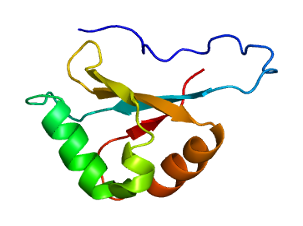Related Research Articles
In genetics, a missense mutation is a point mutation in which a single nucleotide change results in a codon that codes for a different amino acid. It is a type of nonsynonymous substitution.

Beta-glucuronidases are members of the glycosidase family of enzymes that catalyze breakdown of complex carbohydrates. Human β-glucuronidase is a type of glucuronidase that catalyzes hydrolysis of β-D-glucuronic acid residues from the non-reducing end of mucopolysaccharides such as heparan sulfate. Human β-glucuronidase is located in the lysosome. In the gut, brush border β-glucuronidase converts conjugated bilirubin to the unconjugated form for reabsorption. Beta-glucuronidase is also present in breast milk, which contributes to neonatal jaundice. The protein is encoded by the GUSB gene in humans and by the uidA gene in bacteria.

FMR1 is a human gene that codes for a protein called fragile X messenger ribonucleoprotein, or FMRP. This protein, most commonly found in the brain, is essential for normal cognitive development and female reproductive function. Mutations of this gene can lead to fragile X syndrome, intellectual disability, premature ovarian failure, autism, Parkinson's disease, developmental delays and other cognitive deficits. The FMR1 premutation is associated with a wide spectrum of clinical phenotypes that affect more than two million people worldwide.

Glutamate receptor 3 is a protein that in humans is encoded by the GRIA3 gene.

Glutamate receptor, metabotropic 6, also known as GRM6 or mGluR6, is a protein which in humans is encoded by the GRM6 gene.

Metabotropic glutamate receptor 7 is a protein that in humans is encoded by the GRM7 gene.

Glutamate receptor 1 is a protein that in humans is encoded by the GRIA1 gene.

Glutamate ionotropic receptor AMPA type subunit 2 is a protein that in humans is encoded by the GRIA2 gene and it is a subunit found in the AMPA receptors.

Glutamate ionotropic receptor kainate type subunit 2, also known as ionotropic glutamate receptor 6 or GluR6, is a protein that in humans is encoded by the GRIK2 gene.

Glutamate receptor, ionotropic, kainate 1, also known as GRIK1, is a protein that in humans is encoded by the GRIK1 gene.

Glutamate receptor 4 is a protein that in humans is encoded by the GRIA4 gene.

Glutaminyl-tRNA synthetase is an enzyme that in humans is encoded by the QARS gene.

Glutamate receptor, ionotropic kainate 3 is a protein that in humans is encoded by the GRIK3 gene.

ATP-dependent RNA helicase DDX19B is an enzyme that in humans is encoded by the DDX19B gene.

Probable ATP-dependent RNA helicase DDX23 is an enzyme that in humans is encoded by the DDX23 gene.

DEAD (Asp-Glu-Ala-Asp) box polypeptide 31, also known as DDX31, is a human gene.

ATP-dependent RNA helicase DDX50 is an enzyme that in humans is encoded by the DDX50 gene.

Glutamate receptor delta-1 subunit also known as GluD1 or GluRδ1 is a transmembrane protein encoded by the GRID1 gene. A C-terminal GluD1 splicing isoform has been described based on mRNA analysis.
Mitochondrially encoded tRNA glutamic acid also known as MT-TE is a transfer RNA which in humans is encoded by the mitochondrial MT-TE gene. MT-TE is a small 69 nucleotide RNA that transfers the amino acid glutamic acid to a growing polypeptide chain at the ribosome site of protein synthesis during translation.
Within the science of molecular biology and cell biology, for human genetics, the GRIA2 gene is located on chromosome 4q32-q33. The gene product is the ionotropic AMPA glutamate receptor 2. The protein belongs to a family of ligand-activated glutamate receptors that are sensitive to alpha-amino-3-hydroxy-5-methyl-4-isoxazole propionate (AMPA). Glutamate receptors function as the main excitatory neurotransmitter at many synapses in the central nervous system. L-glutamate, an excitatory neurotransmitter, binds to the Gria2 resulting in a conformational change. This leads to the opening of the channel converting the chemical signal to an electrical impulse. AMPA receptors (AMPAR) are composed of four subunits, designated as GluR1 (GRIA1), GluR2 (GRIA2), GluR3 (GRIA3), and GluR4(GRIA4) which combine to form tetramers. They are usually heterotrimeric but can be homodimeric. Each AMPAR has four sites to which an agonist can bind, one for each subunit.[5]
References
- ↑ "Human PubMed Reference:". National Center for Biotechnology Information, U.S. National Library of Medicine.
- ↑ "Entrez Gene: Transfer RNA-Glu (CTC) 1-5" . Retrieved 2018-02-16.